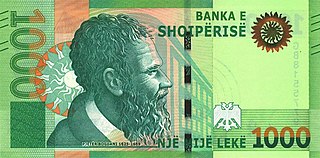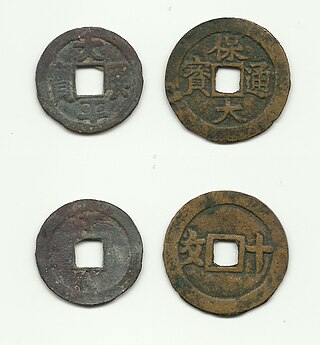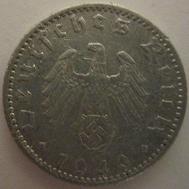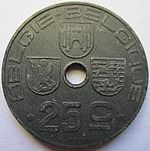The Latin Monetary Union (LMU) was a 19th-century system that unified several European currencies into a single currency that could be used in all member states when most national currencies were still made out of gold and silver. It was established in 1865 and disbanded in 1927. Many countries minted coins according to the LMU standard even though they did not formally accede to the LMU treaty.

The lek is the currency of Albania. Historically, it was subdivided 100 qintars.

The Korean won or Korean Empire won, was the official currency of the Korean Empire between 1902 and 1910. It was subdivided into 100 jeon.

The franc, also commonly distinguished as the French franc (FF), was a currency of France. Between 1360 and 1641, it was the name of coins worth 1 livre tournois and it remained in common parlance as a term for this amount of money. It was reintroduced in 1795. After two centuries of inflation, it was redenominated in 1960, with each new franc (NF) being worth 100 old francs. The NF designation was continued for a few years before the currency returned to being simply the franc. Many French residents, though, continued to quote prices of especially expensive items in terms of the old franc, up to and even after the introduction of the euro in 2002. The French franc was a commonly held international reserve currency of reference in the 19th and 20th centuries.

The Reichsmark was the currency of Germany from 1924 until 20 June 1948 in West Germany, where it was replaced with the Deutsche Mark, and until 23 June 1948 in East Germany, where it was replaced by the East German mark. The Reichsmark was subdivided into 100 Reichspfennigs. The Mark is an ancient Germanic weight measure, traditionally a half pound, later used for several coins; whereas Reich, comes from the official name for the German state from 1871 to 1945, Deutsches Reich.
The Congolese franc is the currency of the Democratic Republic of the Congo. It is subdivided into 100 centimes. However, centimes no longer have a practical value and are no longer used. In April 2022, 2,000 francs was equivalent to US$1.

The Belgian franc was the currency of the Kingdom of Belgium from 1832 until 2002 when the Euro was introduced. It was subdivided into 100 subunits, each known as a centiem in Dutch, centime in French or a Centime in German.

The Luxembourg franc, subdivided into 100 centimes, was the currency of Luxembourg between 1854 and 2002, except in 1941–44. In 1944–2002, its value was equal to that of the Belgian franc. The franc remained in circulation until 2002, when it was replaced by the euro. During the period 1999–2002, the franc was officially a subdivision of the euro, but the euro did not circulate in physical form. Under the principle of "no obligation and no prohibition", financial transactions could be conducted in euros and francs, but physical payments could be made only in francs, as euro notes and coins were not available yet.
This glossary of numismatics is a list of definitions of terms and concepts relevant to numismatics and coin collecting, as well as sub-fields and related disciplines, with concise explanations for the beginner or professional.
The franc was the currency of French Morocco from 1921. It became the currency of all Morocco in 1957 and circulated until 1974. It was divided into 100 centimes.

The Bohemian and Moravian koruna, known as the Protectorate crown, was the currency of the Protectorate of Bohemia and Moravia between 1939 and 1945. It was subdivided into 100 haléřů.

The piastre de commerce was the currency of French Indochina between 1885 and 1952. It was subdivided into 100 cents, each of 2~6 sapèques.

The Swiss franc has been the currency of Liechtenstein since 1920. The Swiss franc is legal tender since Liechtenstein is in a customs and monetary union with Switzerland. The 1980 treaty between Switzerland and Liechtenstein allows Liechtenstein to mint limited amounts of Swiss francs with a Liechtenstein inscription, but only in the form of commemorative coins, and they are not allowed to issue banknotes.

Vietnamese cash is a cast round coin with a square hole that was an official currency of Vietnam from the Đinh dynasty in 970 until the Nguyễn dynasty in 1945, and remained in circulation in North Vietnam until 1948. The same type of currency circulated in China, Japan, Korea, and Ryūkyū for centuries. Though the majority of Vietnamese cash coins throughout history were copper coins, lead, iron and zinc coins also circulated alongside them often at fluctuating rates. Coins made from metals of lower intrinsic value were introduced because of various superstitions involving Vietnamese people burying cash coins, as the problem of people burying cash coins became too much for the government. Almost all coins issued by government mints tended to be buried mere months after they had entered circulation. The Vietnamese government began issuing coins made from an alloy of zinc, lead, and tin. As these cash coins tended to be very fragile, they would decompose faster if buried, which caused the Vietnamese people to stop burying their coins.

Belgium began using national postage stamps on July 8, 1849, when two imperforate stamps, a 10c. brown and 20c. blue, collectively known as Epaulettes, were introduced. A few months later a 40c. red stamp with a new design was issued, for postage to foreign destinations. In 1850 two new stamps of 10c. and 20c. were issued.

The coins of the Swiss franc are the official coins used in Switzerland and Liechtenstein. The name of the subunit is centime in French and internationally, Rappen in German, centesimo in Italian, and rap in Romansh. There are coins in denominations of 5 centimes, 10 centimes, 20 centimes, 1⁄2 franc, 1 franc, 2 francs and 5 francs.

The 50 Reichspfennig coin was minted by Nazi Germany between 1939 and 1944 during World War II. It is worth 1/2 or .50 of a Reichsmark. Made entirely of aluminum, the 50 Reichspfennig is an emergency issue type, similar to the zinc 1, 5, and 10 Reichspfennig coins from the same period.

The zinc 5 Reichspfennig coin was minted by Nazi Germany between 1940 and 1944 during World War II, replacing the bronze-aluminum version, which had a distinct golden color. It was worth 1/20 or .05 of a Reichsmark, the same ratio of a modern day five-cent piece (nickel) to one USD. Made entirely of zinc, the 5 Reichspfennig is an emergency issue type, similar to the zinc 1 and 10 Reichspfennigs, and the aluminum 50 Reichspfennig coins from the same period.

The zinc 1 Reichspfennig coin was minted by Nazi Germany between 1940 and 1945 during World War II, replacing the bronze version. It is worth 1/100 or .01 of a Reichsmark. Made entirely of zinc, the 1 Reichspfennig is an emergency issue type, similar to the zinc 5 and 10 Reichspfennigs, and the aluminum 50 Reichspfennig coins from the same period.

Although the vast majority of coins are round, coins are made in a variety of other shapes, including squares, diamonds, hexagons, heptagons, octagons, decagons, and dodecagons. They have also been struck with scalloped (wavy) edges, and with holes in the middle. Coins in the shape of polygons often have rounded edges or are Reuleaux polygons.

























